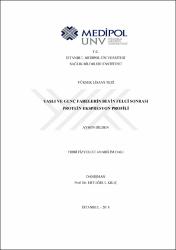| dc.contributor.advisor | Kılıç, Ertuğrul | |
| dc.contributor.author | Dilden, Aysun | |
| dc.date.accessioned | 2021-07-01T08:39:55Z | |
| dc.date.available | 2021-07-01T08:39:55Z | |
| dc.date.issued | 2018 | en_US |
| dc.date.submitted | 2018-01-11 | |
| dc.identifier.citation | Dilden, A. (2018). Yaşlı ve genç farelerin beyin felci sonrası protein ekspresyon profili. (Yayınlanmamış yüksek lisans tezi). İstanbul Medipol Üniversitesi Sağlık Bilimleri Enstitüsü, İstanbul. | en_US |
| dc.identifier.uri | https://hdl.handle.net/20.500.12511/7412 | |
| dc.description.abstract | Beyin felci, dünyada yaygın görülen bir dolaşım sistemi hastalığıdır. Beyni besleyen damarlarda oluşan tıkanma ya da yırtılma ile kan akışının değişmesi sonucunda gelişen patolojik olaylar beyin felcine yol açmaktadır. Beyin felci görülme oranı 65 yaş ve üzerinde oldukça yüksek olduğu için yaşlanma beyin felci için bir risk faktörüdür. İskemik beyin felci görülme sıklığı yaşla birlikte artsa da araştırmalarda kullanılan deney grupları genellikle genç hayvanlardan seçilmektedir. Yaşlı ve genç beyinler arasındaki fizyolojik farkların, geliştirilmeye çalışılan tedavilerin ve bu tedavilerin kliniğe uyarlanmasının başarısızlığına neden olduğu düşünülmektedir. Bu bilgiler doğrultusunda beyin felcinin patofizyolojisinin yaşlı ve genç beyin arasında göstermiş olabileceği farklılıkların incelenmesi, hasarla ilgili mekanizmaların anlaşılması ve buna yönelik ilaçlar geliştirilmesi önem arz etmektedir. Bu tezde yaşlı ve genç farelerde orta serebral arter tıkanması metodu kullanılarak serebral iskemi indüklenmiştir. İskemi sonrası yaşlı ve genç farelerin striatum dokularında nöronal sağkalımın, hasar hacminin, apoptotik hücre sayısının ve kan beyin bariyeri geçirgenliğinin karşılaştırılması amaçlanmıştır. Ek olarak, deney grupları arasında iskemi sonrası protein profili farklılıklarını ortaya koymak adına sıvı kromatografisi kütle spektrometresi ile geniş ölçekli protein profili analizi yapılmıştır. Gruplar arası farklılık gösteren proteinlere sinyal yolağı analizi yapılmış ve bu yolakların hangi mekanizmalarla ilişkili oldukları tespit edilmiştir. Çalışmanın sonucunda genç farelerle kıyaslandığında yaşlı farelerin striatumlarında, iskemi sonrası daha az hasar geliştiği, nöronal sağkalımın daha fazla olduğu, ancak daha fazla apoptotik hücre oluştuğu görülmüştür. Kan beyin bariyeri geçirgenliğinde ise yaşlı ve genç fareler arasında bir fark görülmemiştir. Protein profili analiziyle tanımlanan proteinlerin hasar gelişimi, apoptoz ve nöronal sağkalımda rolü olduğu düşünülmektedir. Bu proteinlerin detaylı incelenmesi ile ilişkilendirildikleri hedef mekanizmalar, klinik tedavi için geliştirilecek yeni hedef moleküllerin bulunmasında önemli rol oynayacaktır. | en_US |
| dc.description.abstract | Cerebral ischemia is a well-known circulatory system disorder that generally occurs in consequence of pathological conditions such as a rupture or a blockage within the blood vessels supplying the brain. Aging is accepted as a risk factor especially in the elderly population over the age of 65. Even though the incidence of cerebral ischemia increases with age, the study groups are mostly chosen from young animals. It is now considered that the physiological differences between the aged and the young animals lead to the failure of development and clinical adaptation of these treatments. In the scope of this knowledge, elucidation of the mechanisms and pathophysiological differences of cerebral ischemia between young and aged animals and drug development with these considerations have become important. In the present thesis study, a cerebral ischemia model has been applied using middle cerebral artery (MCA) occlusion in young and aged animals. The studies focused on the comparison of neuronal survival, the size of infarct area and the number of apoptotic cells in the striatal tissues after the cerebral ischemia. Additionally, liquid chromatography-mass spectrometry was applied to reveal the differences of the protein profiles between the study groups. The differential proteins between the groups were identified and signaling pathway network analyses were performed to find out related mechanisms. According to the results, it was observed that the striatum of aged animals showed less infarct area with higher apoptotic cell number and neuronal survival at 72 hours post-ischemia when compared with young animals. The identified proteins from the protein profile analysis are thought to contribute to the apoptosis, neuronal survival and infarct development. The detailed investigation of these proteins and the correlation between their target mechanisms can reveal new target molecules to be used for development of clinical treatments. | en_US |
| dc.language.iso | tur | en_US |
| dc.publisher | İstanbul Medipol Üniversitesi Sağlık Bilimleri Enstitüsü | en_US |
| dc.rights | info:eu-repo/semantics/openAccess | en_US |
| dc.subject | İskemik Beyin Felci | en_US |
| dc.subject | OSAt | en_US |
| dc.subject | Proteomiks | en_US |
| dc.subject | Serebral İskemi | en_US |
| dc.subject | Yaşlı ve Genç Fareler | en_US |
| dc.subject | Cerebral Ischemia | en_US |
| dc.subject | MCAo | en_US |
| dc.subject | Proteomics | en_US |
| dc.subject | Young and Aged Animals | en_US |
| dc.title | Yaşlı ve genç farelerin beyin felci sonrası protein ekspresyon profili | en_US |
| dc.title.alternative | The protein expression profile of old and young mice after cerebral ischemia | en_US |
| dc.type | masterThesis | en_US |
| dc.department | İstanbul Medipol Üniversitesi, Sağlık Bilimleri Enstitüsü, Fizyoloji Ana Bilim Dalı | en_US |
| dc.relation.publicationcategory | Tez | en_US |


















